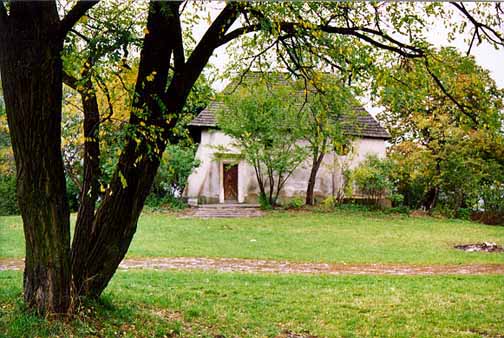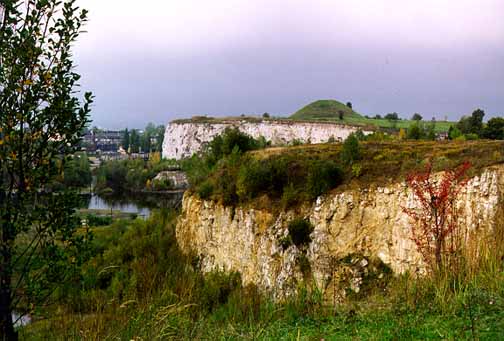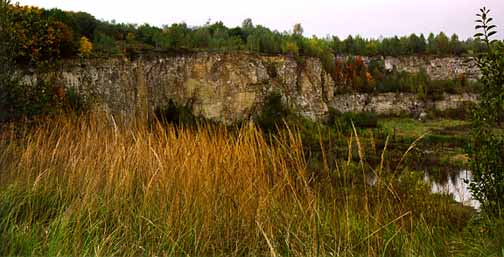Plaszow Concentration Camp
 Bednarskiego Park with
mound of Prince Krak in the background
Bednarskiego Park with
mound of Prince Krak in the background
Pictured above is Bednarskiego Park which
is located between the Plaszow camp and the Podgorze ghetto in
Krakow. You can see the mound of Prince Krak in the background.
Beyond the mound is the granite quarry of the Plaszow camp. On
the opposite side of the park, behind the woman playing with
her dogs, is the Podgorze ghetto (not shown in the picture) and
the path where Oskar Schindler rode his horse and observed what
was going in the ghetto.
Not mentioned in the movie, nor the novel
on which Schindler's List was based, is the fact that the Plaszow
concentration camp was located in an historic area. The mound,
which some paople say is the burial mound of Prince Krak, the
founder of the city of Krakow, who died in 966, is on a hill
overlooking the historic Liban quarry where the Polish prisoners
in the Plaszow camp worked. Many archelogical excavatons have
been done at the mound, but no grave has ever been found there.
The mound was probably built in the 8th or 9th century, as was
another mound in Krakow called Wanda's mound, named after the
daughter of Prince Krak. The legend is that Prince Krak slew
a dragon who lived in a cave below Wawel hill. A bronze dragon
which periodically spits fire is the delight of tourists visiting
Wawel hill.
Curiously, the author of the novel "Schindler's Ark" mentions the mound of Tadeusz Kosciuszko, the Polish General who fought in the American Revolution, but doesn't mention the mound of Prince Krak which was visible from the Plaszow camp. Kosciuszko's mound, which was built in the 19th century, is west of the city center. Another mound was constructed in 1937 to honor Marshall Josef Pilsudski, the most important Polish national leader in the 20th century.
The photo below shows St. Benedictus
church, which is in the park. I was told by my tour guide that
this was originally an ancient chapel for the Slavic pagan religion
which was the original religion in Poland before the country
was converted to Christianity in 966 by St. Adalbert. According
to my guide, a religious service is conducted at this church
once a year. Like the Irish, the Poles have incorporated some
of their pagan customs into Christianity.
 St. Benedictus Church
in Bednarskiego Park
St. Benedictus Church
in Bednarskiego Park
Rising majestically above where Spielberg
filmed his movie, the old Liban granite quarry at Plaszow is
the place from which the stones were taken to build the first
buildings in the city of Krakow in the 13th century. One reason
this spot was originally chosen as the site of the Plaszow labor
camp was because Hitler, who was a frustrated architect, had
big plans for building classic buildings in his Thousand Year
Reich. Many other Nazi camps were located at sites where building
materials were available, including the infamous Mauthausen camp
near Hitler's boyhood home in Linz, Austria, which was also located
at a granite quarry.
The pictures below show the Liban quarry
from which the stones to build the city of Krakow were taken;
this was the quarry that was reopened when the Plaszow camp was
built near it. In the background is the mound of Prince Krak,
which looks like those left by Native American mound builders
in Missouri or Wisconsin.
The second picture below was taken from
the same spot as the first picture, on a high bluff overlooking
the quarry, and is the view of the other end of the quarry. (Notice
that the tree that is on the left in the first shot is the same
tree that is on the right in the second shot, as the camera panned
to the left.) It was in this spot below the granite face of the
quarry that Stephen Spielberg constructed barracks buildings,
like those in the original camp, for his movie; the buildings
were torn down when the movie was finished. The area where the
Spielberg barracks formerly stood was flooded, following a rain,
when I was there. According to the tour guide, this was where
the first Plaszow prisoners worked, but not where the original
camp barracks were located.
 Liban Granite quarry
outside Krakow with burial mound of Prince Krak
Liban Granite quarry
outside Krakow with burial mound of Prince Krak
 Opposite end of Liban
quarry where Spielberg built barracks for movie
Opposite end of Liban
quarry where Spielberg built barracks for movie
The Liban quarry was officially closed to visitors in 1998, when I saw it, but it was possible to go down into it. In the quarry, the road that was made with old Jewish tombstones taken from the cemetery in Podgorze was reconstructed for the movie Schindler's List. The reconstructed road can be seen on this web site.
This page was last updated on July 17, 2012
|